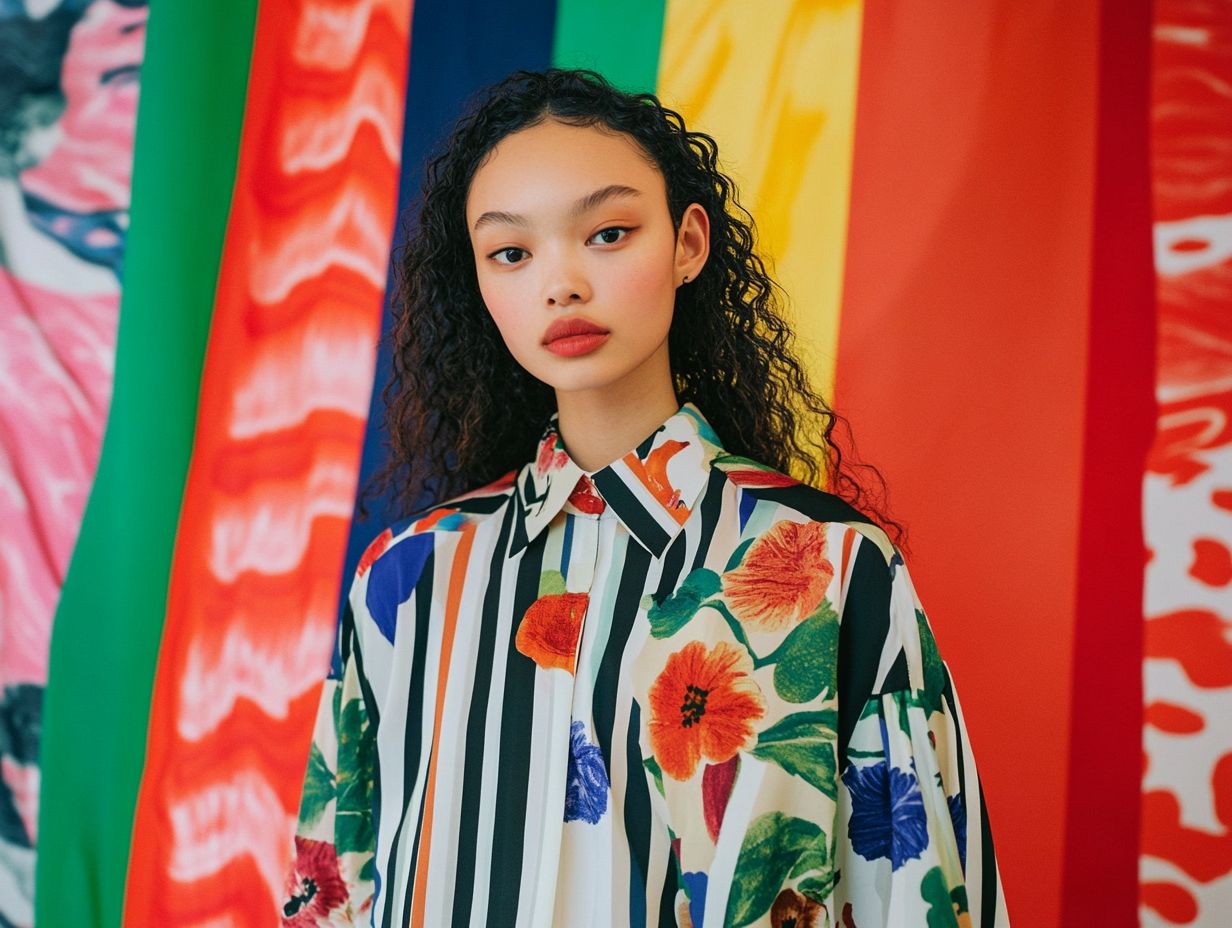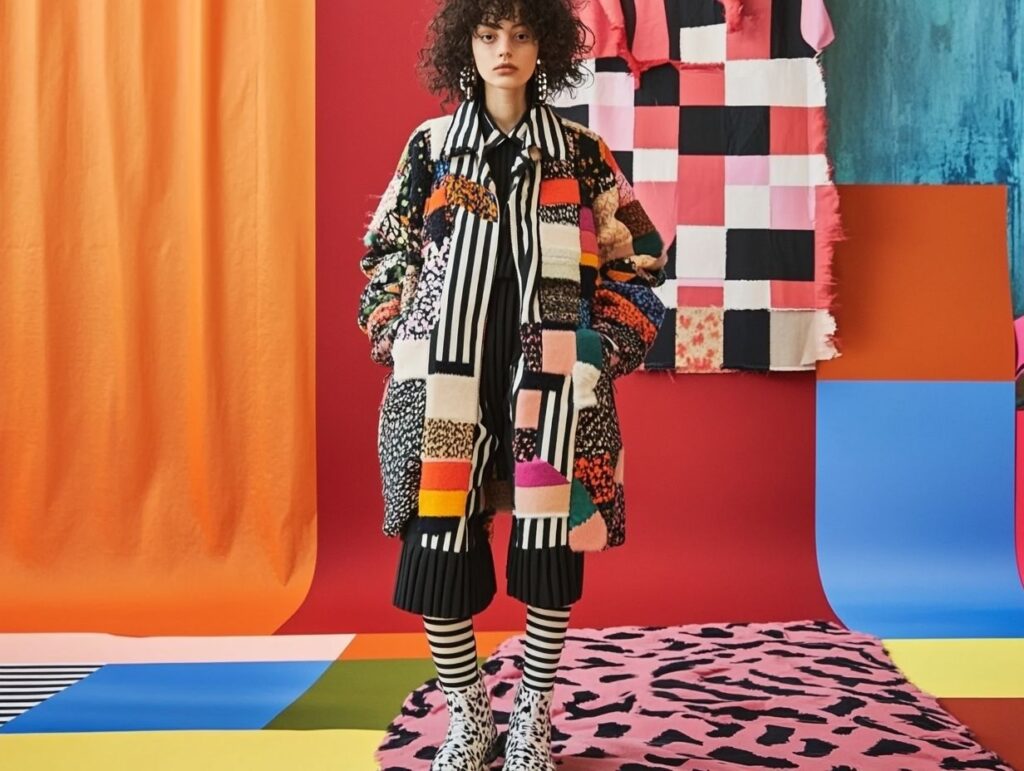Pattern mixing is more than just a trend; it is an exciting method of expressing individuality through fashion. By skillfully combining different prints, you can create unique looks that reflect your personal style. This guide explores the fundamentals of pattern mixing, including an understanding of various types of patterns and the benefits they can bring to your wardrobe. You will find practical tips for mastering this technique, avoiding common mistakes, and incorporating patterns into outfits for every occasion. Get ready to elevate your style game!
Understanding Pattern Mixing

Pattern mixing is a design technique that involves the careful combination of various patterns, including geometric, floral, and bold designs, to create a balanced aesthetic in interior spaces.
Notable examples of successful pattern mixing can be seen in the work of professionals like Lark Interiors and Kelly Wearstler, who demonstrate how layering textures within a cohesive color palette can enhance any interior design project.
By identifying common threads and introducing textural interest, individuals can embark on a design journey that allows them to express their creativity.
What is Pattern Mixing?
Pattern mixing in interior design is the technique of combining various patterns to create visual interest and depth within a space. This approach can transform an ordinary room into an engaging environment that captures attention and sparks conversation.
Designers often incorporate geometric patterns, which provide structured and angular forms, alongside organic patterns that mimic the fluid lines of nature, resulting in a harmonious juxtaposition. Floral prints are also popular, adding a touch of vibrancy and femininity.
A prime example of successful pattern mixing can be seen in the renowned designs of Kelly Wearstler, where bold stripes blend seamlessly with intricate paisleys, enhancing the character of the room. The careful combination of these diverse patterns can elevate the overall aesthetic of an interior, creating a captivating visual narrative.
Benefits of Pattern Mixing
The benefits of pattern mixing in interior design include increased creative opportunities and the enhancement of the overall visual experience within interior spaces.
By combining different patterns, textures, and colors, designers can create a dynamic composition that is visually striking and intriguing. When executed effectively, pattern mixing can yield a cohesive look that unifies elements that might otherwise appear disparate.
This approach allows for innovative design solutions that enrich the spatial experience, fostering emotional resonance for those who inhabit the space. Through careful selection and combination of various patterns, designers can construct a narrative that resonates with individuals, infusing a sense of personality and warmth into the environment.
Choosing the Right Patterns
The selection of patterns is one of the most crucial aspects of designing a harmonious space, as it influences how the various elements within that space interact and complement each other.
Complementary vs. Contrasting Patterns

Complementary patterns are those that work harmoniously together and enhance one another. These patterns typically refer to colors that are directly opposite each other on the color wheel, resulting in a balanced color palette.
For instance, pairing a soft blue floral pattern with a soft yellow stripe pattern can create a calm and inviting atmosphere. Such combinations are often found in spaces like bedrooms or reading nooks.
In contrast, contrasting patterns consist of designs that are markedly different from one another, such as a bold geometric pattern paired with a delicate floral design. These types of patterns can generate an energetic and exciting atmosphere, making them more commonly seen in living areas or the workspaces of creative individuals.
The key to successfully mixing complementary and contrasting patterns lies in maintaining a balance between the scale and intensity of colors. Larger patterns can serve as focal points in a space, while smaller patterns can add texture and depth, creating a rich visual experience without overwhelming the observer.
Considerations for Different Types of Patterns
Here are some best practices for mixing geometric, organic, and floral patterns:
- Scale and Proportion: When combining patterns, it is crucial to consider their scale and proportion, as this can result in a more visually appealing arrangement. For example, a large geometric pattern can pair well with smaller floral designs.
- Textures and Colors: The textures and colors of the individual fabrics are also important. It’s advisable to select patterns that share a common color scheme or feature complementary tones.
- Layering: Mixing geometric, organic, and floral patterns can enhance the visual interest of a space. These patterns can be used alongside other textiles, such as pillows, throws, and curtains, to create a warm and inviting atmosphere.
Tips for Mastering Pattern Mixing
The key to mastering pattern mixing lies in thoughtfully layering textures and understanding how scale and proportion influence the overall design of a space.
Start Small and Build Confidence
Beginning with a selection of carefully chosen fabrics can facilitate a smooth transition into mixing patterns and offer a way to experiment in manageable steps.
Using accessories or smaller decorative elements, such as throw pillows or rugs, is an excellent starting point. These items add visual interest and allow for experimentation with color and texture combinations without overwhelming an entire room.
Since comfort is essential for successful design, selecting fabrics that promote comfort can enhance the overall aesthetic. As the individual becomes more confident in mixing patterns, they can gradually progress to larger pieces and bolder designs.
Experiment with Different Combinations

Experimenting with various combinations of patterns can lead to the discovery of a unique style that resonates with personal taste and enhances interior spaces.
For example, pairing bold geometric prints with soft florals can create a dynamic yet balanced ambiance that feels both inviting and sophisticated.
Mixing stripes with polka dots introduces a playful element to a room, inviting curiosity and engagement from guests.
Encouraging readers to explore diverse combinations not only fuels their creativity but also allows them to curate an environment that genuinely reflects their individual flair.
This journey of experimentation can transform ordinary spaces into reflections of the homeowner’s personality, sparking joy and inspiration in every corner.
Using Accessories to Enhance Patterns
Strategically using accessories can enhance the patterns within a space, creating a dynamic interplay of textures and colors. This approach allows homeowners and designers to craft a lively environment that reflects personal style while maximizing visual interest without overwhelming the senses.
Thoughtful integration of elements such as pillows, rugs, and wall art can harmonize bold designs, ensuring that each accessory contributes to an overall cohesive look rather than competing for attention.
When selecting accessories, it is advisable to choose complementary colors that echo the dominant patterns, utilize textures to add depth, and balance larger pieces with smaller, subtler accents to maintain an engaging yet unified aesthetic.
Mistakes to Avoid
It is important to avoid common mistakes in pattern mixing, as they can easily occur and may result in the opposite of your desired outcome, even if you have a clear vision for the space.
Overdoing it with Too Many Patterns
Mixing patterns in fashion is a popular form of self-expression; however, one of the most common mistakes is using too many patterns, which can disrupt the balance of a design and diminish its visual interest.
Such pattern mixing errors can lead to clothing that lacks aesthetic appeal and can even become distracting. The most successful pattern mixing strategies involve a thoughtful approach to the number of patterns used, ensuring a high level of style.
A good rule of thumb is to select three or fewer patterns to combine. Begin with a dominant base pattern, and then add one or two additional patterns that share a similar color palette or theme. This approach not only creates a cohesive look but also allows the patterns to complement one another effectively.
Additionally, layering solid colors or textured fabrics can help achieve a balanced overall appearance, enhancing the visual appeal of the mixed patterns without overshadowing them.
Clashing Colors and Prints

Clashing colors and prints can create a chaotic environment, so it is essential to understand the relationships between patterns. Color theory provides valuable insights on how to mix patterns effectively.
By grasping how colors interact, one can select shades that harmonize as well as those that might clash, resulting in a more balanced look. For instance, using analogous colors—those positioned next to each other on the color wheel—creates a natural and cohesive match.
In contrast, colors that are opposite each other on the wheel should be used sparingly to avoid overwhelming the eye. To ensure that each piece of an outfit shines without competing with one another, limit the number of patterns and incorporate neutral shades to ground the overall look.
Incorporating Pattern Mixing into Your Wardrobe
Pattern mixing not only showcases an individual’s personal style but also enhances the functionality of both work and casual clothing, providing tips and ideas for a unique look that reflects the wearer’s style and personality. This design adventure can lead to creative expression through the use of bold patterns and layered textures.
Workwear vs. Casual Outfits
Workwear and casual outfits differ significantly in their approach to pattern mixing. While workwear should maintain a level of professionalism, it can still allow for a unique look by incorporating statement patterns or a neutral base that blends seamlessly with the overall design.
In contrast, casual outfits can embrace a more liberal and playful approach to pattern combinations. In a work setting, it is essential to strike a balance that conveys confidence without distracting others. Subtle patterns, such as pinstripes, small checks, or houndstooth, can add sophistication to workwear while enabling the wearer to express their individuality.
In casual settings, bolder combinations are more than welcome; for instance, pairing a geometric patterned blouse with floral print trousers can create a light and fun atmosphere.
Context plays a crucial role: a tailored blazer over patterned trousers can elevate an outfit for the office, while freely mixing vibrant prints in a weekend brunch outfit can result in a stylish and effortless look.
Seasonal Considerations
Seasonal considerations play a significant role in pattern mixing, as different patterns and colors are suited for various times of the year. By including elements like plaid and animal prints, one can create a harmonious design that adapts well to seasonal changes.
For example, in summer, lighter fabrics and brighter colors can be combined with floral prints and geometric patterns to create a fresh and cheerful look. In contrast, winter attire can incorporate heavier fabrics and darker colors, allowing for the pairing of plaid, tartan, and animal prints with softer, more muted designs.
Transitioning patterns throughout the year requires a keen eye for color and texture compatibility; for instance, a bold patterned scarf can easily complement a solid winter coat.
By carefully selecting patterns based on the season, individuals can create unique outfits that reflect their personal style while also embracing the seasonal changes in the world around them. This approach can also be applied to home decor, where a common element like a neutral base can tie together various patterns for a cohesive look inspired by designers such as Kelly Wearstler or Mark Sikes.











